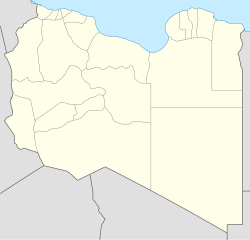Misurata
|
Misrata Misurata |
|
|---|---|

A central park in Misurata
|
|
| Location in Libya | |
| Coordinates: 32°22′39.12″N 15°05′31.26″E / 32.3775333°N 15.0920167°ECoordinates: 32°22′39.12″N 15°05′31.26″E / 32.3775333°N 15.0920167°E | |
| Country |
|
| Region | Tripolitania |
| District | Misurata |
| Government | |
| • Mayor | Muhammad Ishtewie |
| Elevation | 30 ft (10 m) |
| Population (2012) | |
| • Total | 281,000 |
| Demonym(s) | Misrati |
| Time zone | EET (UTC+2) |
| Area code(s) | 31 |
Misurata /mɪzˈrɑːtə/ (Arabic: مصراتة Miṣrātah, Libyan Arabic: IPA: [məsˤˈrˤɑːtæ]), also spelled Misrata or Misratah, is a city in the Misrata District in northwestern Libya, situated 187 km (116 mi) to the east of Tripoli and 825 km (513 mi) west of Benghazi on the Mediterranean coast near Cape Misurata. With a population of about 281,000, Misrata is the third-largest city in Libya, after Tripoli and Benghazi. It is the capital city of the Misurata District and has been called the trade capital of Libya. The harbor is at Qasr Ahmad.
The name "Misurata" derives from the Misrata tribe, a section of the larger Berber Hawwara confederacy, whose homeland in Roman and early Arab times was coastal Tripolitania. "Trirone Acrone", The oldest description mentioned by Ptolemy III Euergetes of Misurata because it consists of three heads of land stretching into the sea depth, and got Misurata importance by being at the crossroads of many convoys and also because it is in the middle of an agricultural area as the name of "Cephalae Promentorium" (Kevalay) Greek geographer Strabo. And the city of Misurata is one of the commercial stations that have been built by the Phoenicians, since more than 3000 years (The Tenth Century BC) to the north-western parts of the Libyan coast. The flag then by the name of "Thubactis" Misurata and know that name in relation to the Berber tribe of Misurata (The Misurateens), which means the sailors.
...
Wikipedia

